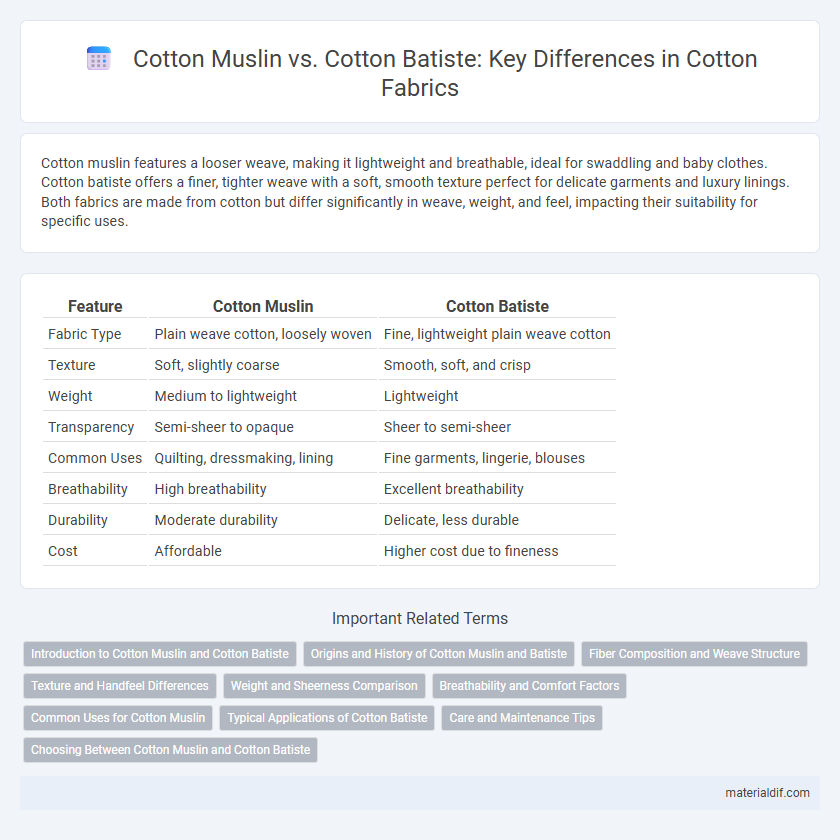Cotton muslin features a looser weave, making it lightweight and breathable, ideal for swaddling and baby clothes. Cotton batiste offers a finer, tighter weave with a soft, smooth texture perfect for delicate garments and luxury linings. Both fabrics are made from cotton but differ significantly in weave, weight, and feel, impacting their suitability for specific uses.
Table of Comparison
| Feature | Cotton Muslin | Cotton Batiste |
|---|---|---|
| Fabric Type | Plain weave cotton, loosely woven | Fine, lightweight plain weave cotton |
| Texture | Soft, slightly coarse | Smooth, soft, and crisp |
| Weight | Medium to lightweight | Lightweight |
| Transparency | Semi-sheer to opaque | Sheer to semi-sheer |
| Common Uses | Quilting, dressmaking, lining | Fine garments, lingerie, blouses |
| Breathability | High breathability | Excellent breathability |
| Durability | Moderate durability | Delicate, less durable |
| Cost | Affordable | Higher cost due to fineness |
Introduction to Cotton Muslin and Cotton Batiste
Cotton Muslin is a loosely woven, breathable fabric often used for lightweight garments, curtains, and medical applications due to its softness and durability. Cotton Batiste, on the other hand, is a finer, semi-sheer fabric with a smooth finish, favored for delicate apparel like dresses and linings. Both fabrics are 100% cotton, but they differ significantly in texture, weave tightness, and typical use cases.
Origins and History of Cotton Muslin and Batiste
Cotton Muslin originated in ancient South Asia, particularly in Bengal, where it was renowned for its fine, lightweight texture and intricate weaving techniques dating back to the Mughal era. Cotton Batiste, originating in 19th-century France, evolved as a smooth, semi-sheer fabric favored for delicate garments and luxury linings. Both textiles reflect distinct historical craftsmanship: Muslin's handwoven heritage contrasts with Batiste's machine-produced refinement during the Industrial Revolution.
Fiber Composition and Weave Structure
Cotton Muslin is a lightweight, plain weave cotton fabric made from loosely spun, carded cotton fibers, resulting in a soft, breathable texture ideal for casual wear and draping. Cotton Batiste features a finer, tighter plain weave constructed from combed, long-staple cotton fibers, producing a smooth, semi-sheer fabric often used in delicate garments and linings. The key differences lie in fiber preparation and weave density, with Muslin's airy structure contrasting Batiste's refined finish.
Texture and Handfeel Differences
Cotton Muslin features a coarser weave and a more textured surface, offering a slightly rougher handfeel that softens with washing. In contrast, Cotton Batiste has a fine, tight weave that results in a smoother, lightweight fabric with a delicate and silky hand. Muslin is often preferred for its breathability and rustic texture, while batiste appeals for softness and subtle sheen in garments.
Weight and Sheerness Comparison
Cotton muslin is typically heavier and coarser with a more open weave compared to lightweight, finely woven cotton batiste, which offers a smoother texture and greater sheerness. Muslin's denser yarns result in a sturdier fabric ideal for dressmaking and quilting, while batiste's delicate weight and translucent quality make it popular for linings and summer garments. The distinct differences in weight and sheerness influence their practical applications, with muslin providing durability and batiste offering breathability and softness.
Breathability and Comfort Factors
Cotton muslin offers superior breathability thanks to its loosely woven structure, making it ideal for warm weather and sensitive skin by allowing air to circulate freely. Cotton batiste, while lightweight and finely woven, provides a smoother texture with moderate breathability, often favored for delicate garments and summer wear. Both fabrics deliver comfort, but muslin's open weave ensures enhanced airflow, reducing heat retention compared to the denser weave of batiste.
Common Uses for Cotton Muslin
Cotton muslin is commonly used for lightweight clothing, quilting, and as a fabric for pattern making due to its breathable and soft texture. It serves as an ideal material for curtains, linings, and reusable food wraps because of its loose weave and durability. In contrast to cotton batiste, muslin offers a coarser finish suitable for utilitarian purposes and creative projects requiring easy handling.
Typical Applications of Cotton Batiste
Cotton batiste is typically used for delicate garments such as lingerie, baby clothes, and handkerchiefs due to its fine, lightweight, and semi-sheer texture. It is also favored in summer apparel and elegant blouses where breathability and a soft drape are essential. Unlike cotton muslin, batiste provides a refined finish suitable for intricate sewing and embroidery projects.
Care and Maintenance Tips
Cotton muslin and cotton batiste require gentle washing techniques to maintain their delicate textures and prevent shrinkage; opt for cold water and mild detergents when laundering. Avoid high heat drying by air-drying or using low heat settings to preserve fabric integrity and prevent wear. Iron on a low to medium heat setting while fabrics are slightly damp to smooth wrinkles and maintain softness without damaging fibers.
Choosing Between Cotton Muslin and Cotton Batiste
Cotton Muslin is a loosely woven, breathable fabric ideal for lightweight garments and home textiles, offering a soft yet textured feel. Cotton Batiste, in contrast, is finely woven, smooth, and semi-sheer, making it perfect for delicate apparel and linings. Choosing between the two depends on the desired texture, weight, and opacity for your specific project.
Cotton Muslin vs Cotton Batiste Infographic

 materialdif.com
materialdif.com